Highlighting Food Safety and Quality at IFT16
FOOD SAFETY & QUALITY PREVIEW
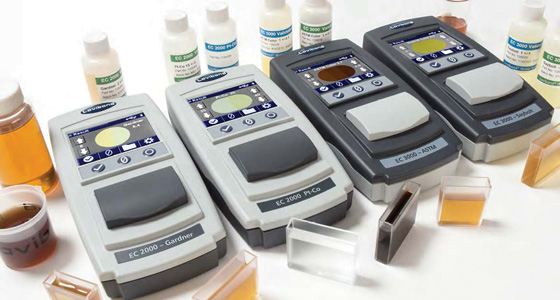
The Scientific Program at IFT16 in Chicago, July 17–19, 2016, will feature more than 100 sessions, more than 700 printed poster presentations, and 140 e-poster presentations that food scientists and related professionals will find valuable. The following are brief descriptions of symposia related to food safety and quality.
Food Safety
In session 008, “Improving Microbial Safety of Locally Grown Fresh Produce in Several U.S. States Through Research and Extension Approaches,” on Sunday, July 17, from 8:30 a.m. to 10 a.m., Hanna Khouryieh will discuss surveys of fresh produce growers in Kentucky regarding their understanding and implementation of good agricultural practices; Cangliang Shen will discuss the microbial quality and presence or absence of foodborne pathogens on fresh produce at farmers markets in West Virginia; Sujata Sirsat will discuss development of a sanitizing station to improve leafy green safety for small farmers, market vendors, and managers in southern Texas; and Yifan Zhang will discuss the prevalence of foodborne bacteria, heavy metals, and chemical contaminants in soil and vegetables and guidance on growing food safely and sustainably.
In session 013, “Attachment, Detachment, and Inactivation of Allergens and Microbes on Food Contact Surfaces,” on Sunday, July 17, from 8:30 a.m. to 10 a.m., Lauren S. Jackson will discuss engineering approaches to control pathogens, biofilms, and allergens on food surfaces; Julie M. Goddard will describe food processing surface coatings incorporating N-halamine that are able to regenerate antimicrobial activity after re-chlorination and prolonged exposure to chemical agents; Mukund V. Karwe will discuss factors that influence the attachment and detachment of microorganisms on fresh produce during washing; and Philip Demokritou will tell how chemical-free engineered water nanostructures synthesized by electrospraying and ionization inactivate microorganisms in air and on surfaces.
In session 014, “Emerging Tools and Future Needs for Meeting FSMA Requirements Related to Economically Motivated Adulteration (EMA) Hazard Analysis and Preventive Controls,” on Sunday, July 17, from 8:30 a.m. to 10 a.m., John Spink will describe global challenges and initiatives in meeting the Food Safety Modernization Act (FSMA) hazard analysis and preventive controls rules to combat food fraud, Karen Everstine will describe use of the U.S. Pharmacopeial Convention’s Food Fraud Database to identify EMA-vulnerable ingredients and hazards, Jonathan W. DeVries Sr. will discuss use of the USP’s “Guidance on Food Fraud Mitigation” to evaluate vulnerabilities and establish EMA mitigation programs, Steven Gendel will point out critical gaps in analysis of EMA involving food allergens, and Liwen Chen will discuss use of the USP’s Food Chemicals Codex standard for developing preventive controls and verification procedures.
In session 022, “Toxicological Science: Risk, Communication, and Regulation,” on Sunday, July 17, from 2 p.m. to 3:30 p.m., Michael P. Holsapple will describe toxicology research at Michigan State University’s Center for Research on Ingredient Safety, Charlie Arnot will discuss communicating scientific information about food safety to consumers, and Neal Fortin will discuss whether the Generally Recognized as Safe (GRAS) designation of ingredients clarifies the risks and regulatory status of food ingredients.
In session 028, “Critical Considerations in Pathogen Surrogate Identification and Utilization for Nonthermal Food Process Testing and Food Safety Verification,” on Sunday, July 17, from 2 p.m. to 3:30 p.m., Doris H. D’Souza will discuss the survival characteristics and inactivation of cultivable enteric viruses used as a research surrogate for human noroviruses, James S. Dickson will describe the search for non-pathogenic bacteria that can be used as a surrogate for foodborne pathogens in validation of high-pressure processing, Thomas M. Taylor will discuss antimicrobial-tolerance tests to identify surrogate organisms for use in food process validations, and Lee Johnson will discuss use of high hydrostatic pressure and other nonthermal processes in food safety verification.
In session 037, “Safety of Imported Food Ingredients and the Role of the Food Safety Modernization Act,” on Monday, July 18, from 10:30 a.m. to noon, Roger T. Lawrence will describe challenges facing regulation of imported food ingredients; Kathy Gombas will discuss the FSMA regulations and compliance timelines and the U.S. Food and Drug Administration’s Technical Assistance Network; Purnendu C. Vasavada will describe the Food Safety Preventive Controls Alliance standardized curriculum on preventive controls for hazards; and Venugopal K.J. Menon will discuss why it is crucial to evaluate the existing practices, needs, and resources of exporting countries for training personnel in food safety.
In session 050, “Economically Motivated Adulteration: Challenges and Innovations in the Detection of Food Fraud,” on Monday, July 18, from 12:30 p.m. to 2 p.m., George F. Hughes will describe activities of the Office of Criminal Investigations of the U.S. Food and Drug Administration (FDA) regarding food fraud; Luis Rodriguez-Saona will describe portable vibrational spectroscopy instruments for rapid onsite screening for EMA of food ingredients; John H. Kalivas will discuss use of chemometrics and fluorescence spectroscopy to detect and quantify EMA of Argan oil and extra virgin olive oil and use of ICP-MS for detection of EMA of yellow split pea and beer; and Nicholas Phelps will discuss mislabeling of walleye, halibut, tuna, and salmon in Minnesota retail markets.
In session 054, “Infant Formula Nutrition: Regulatory and Safety Evaluation of Ingredients,” on Monday, July 18, from 12:30 p.m. to 2 p.m., Roger A. Clemens will discuss innovations in infant formula, including technologies to reduce cow milk and soy protein allergenicity and addition of docosahexaenoic acid to improve cognitive development and visual acuity; Claire L. Kruger will discuss factors that must be considered for a GRAS determination for an infant formula ingredient, including animal pharmacokinetic and toxicology studies and clinical trials; Bjorn A. Thorsrud will discuss use of neonatal pigs as a research model for preclinical testing of novel ingredients for use in infant formula; and Carrie L. Assar will discuss the composition, processing conditions, and clinical data required for infant formula.
In session 055, “FSMA: Pain, Progress, and Promise,” on Monday, July 18, from 12:30 p.m. to 2 p.m., Joseph Levitt will describe the preventive controls for human foods rule, David Gombas will discuss produce safety standards, Steve Armstrong will present a produce industry perspective, and Robert E. Brackett will discuss FSMA implementation and training requirements.
In session 062, “Whole Genome Sequencing Enhances Food Safety by Rapidly and Accurately Detecting Pathogens in Food Products,” on Monday, July 18, from 12:30 p.m. to 2 p.m., Melinda Hayman will describe use of whole genome sequencing (WGS) in investigation of foodborne outbreaks; Trevor V. Suslow will discuss use of WGS and molecular methods for tracking the source of Listeria in fresh-produce packing facilities; and Mitchell Holland will describe how BioVelocity, a bioinformatics tool, identifies single nucleotide polymorphisms from WGS and rapidly distinguishes common variants between strains of pathogens.
In session 067, “How Interoperability and Traceability Improve Food Safety,” on Monday, July 18, from 2:15 p.m. to 3:45 p.m., Michele Southall will discuss interoperable food traceability lessons learned from other industries and initiatives in the food sector; Ed Treacy will describe how the produce sector responded to foodborne outbreaks by proactively enabling electronic traceability and interoperability; and Tejas Bhatt will discuss the need for globally aligning people, products, processes, policies, and protocols to realize the potential of interoperable food traceability.
In session 077, “Generally Recognized as Safe (GRAS) in the New Millennium of Technology and Food Science,” on Tuesday, July 19, from 8:30 a.m. to 10 a.m., Alex LeBeau will discuss how common use in food as a basis for determining the GRAS status of a substance came about and has been replaced; Ed Collins will describe specifications and analytical methods for an ingredient to meet FDA requirements; and Ted Broering will discuss design, conduct, analysis, auditing, and validation of pre-clinical trials to support a GRAS or food additive petition.
In session 082, “Corporate Spending on Food Protection: Without Knowing the Cost, How Can You Know the ROI?” on Tuesday, July 19, from 8:30 a.m. to 10 a.m., Sanaz S.H. Haratifar will describe a study of Canadian food companies that provided evidence of how confusing and vague food safety training metrics are when assessing program performance, Sylvain Charlebois will discuss assessing change in outcomes and behavior after training has occurred, and Joan Vanden Hazel will discuss how innovative solutions for training and education in food safety can enable long-term change in behavior.
In session 093, “Recent Advancements in Light-Based Technologies for Enhancing Food Safety,” on Tuesday, July 19, from 10:30 a.m. to noon, Tatiana Koutchma will discuss ultraviolet light as an alternative or addition to traditional heat pasteurization of opaque foods and beverages such as juices and milk; Carmen I. Moraru will discuss ultraviolet, pulsed-light, and light-emitting-diode technologies and factors that affect their effectiveness; Alvin Lee will illustrate how light-based technologies are effective in inactivating myriad viruses; and Glenn Black will discuss process validation of light-based technologies to reduce microbiological risk in food processing.
In session 097, “Nanotechnology and Food: What Are the Opportunities and Challenges?” on Tuesday, July 19, from 10:30 a.m. to noon, Lauren S. Jackson will address problems associated with current analytical methods and advances in detection of food allergens by nanotechnology, Timothy V. Duncan will describe biosensors based on semiconducting nanocrystals (quantum dots) for detection of botulinum neurotoxin, Alex LeBeau will discuss advantages and regulation of nanotechnology, and Odete Mendes will discuss physicochemical characterization of nanomaterials and assessing their safety in food products.
In session 102, “Application of Cold Chain Management to Improve Food Safety of Refrigerated/Frozen Products During Harvesting, Processing, Transportation, Handling, and Consumption,” on Tuesday, July 19, from 10:30 a.m. to noon, Sanjay Gummalla will discuss the new federal regulation that requires retailers, distributors, manufacturers, and suppliers to monitor and document ingredient and product storage and transport; Subramaniam Sathivel will discuss temperature control of food from harvesting or slaughter to end use; William Adams will focus on hazards associated with broken cold chains; and Dennis R. Heldman will discuss how the freezing process and the temperature during storage and distribution affect the quality of frozen products.
In session 109, “Yes We GRAS! Enzymes as Catalysts for Successful Application of the GRAS Process,” on Tuesday, July 19, from 1:15 p.m. to 2:45 p.m., Lori Gregg will discuss enzyme development, use, and safety; Diane Shanahan will discuss assessing the potential allergenicity of enzyme proteins and the safety of protein-engineered enzymes; Vincent Sewalt will address the safety of microbial food enzymes and safe strain lineages for the production of enzymes; and James LaMarta will discuss the methodology utilized by the United States and international regulatory agencies for assessing food enzyme safety.
In session 111, “Alternative Approaches to Control Foodborne Pathogens,” on Tuesday, July 19, from 1:15 p.m. to 2:45 p.m., Anup Kollanoor Johny will describe plant-derived compounds that can serve as alternatives to antibiotics or work synergistically with them; Mathew Taylor will discuss the ability of fermentative non-pathogenic bacteria, bacteriophages, and antimicrobial fermentates to control O157 and non-O157 Shiga toxin-producing Escherichia coli in beef before and after harvest; Kumar Venkitanarayanan will discuss the effectiveness of lactic acid bacteria against biofilms of Listeria monocytogenes on food processing surfaces and cantaloupes; and Mary Anne Amalaradjou will discuss the potential of probiotics directly fed to poultry to reduce the intestinal load of Salmonella and subsequent contamination in poultry production.
Food Quality
In session 044, “Critical Factors Influencing the Oxidative Stability and Shelf Life of Lipid-Containing Foods,” on Monday, July 18, from 10:30 a.m. to noon, Karen M. Schaich will address problems of conventional analytical methods for measuring lipid oxidation and present a new analytical paradigm providing a more complete and accurate assessment of oxidative degradation in foods, Fereidoon Shahidi will discuss factors affecting oxidation of muscle foods and how antioxidants may arrest oxidation in foods, Min Hu will discuss factors affecting the oxidative stability and shelf life of low-moisture foods containing fats and oils, and John L. Koontz will describe packaging technologies that maintain oxidative stability and extend the shelf life of packaged foods.
In session 091, “Natural Colors: Challenges and Chances in a Global Perspective,” on Tuesday, July 19, from 10:30 a.m. to noon, Felicia Ellison will discuss spirulina extract as an example of the FDA’s scientific safety evaluation of a color additive derived from a biological source; M. Monica Giusti will discuss the chemical structure, color, and stability of acylated and non-acylated anthocyanins; Marcus Volkert will describe the food engineering challenges that GNT faced in developing and manufacturing its EXBERRY natural colors; and Erika B. Smith will discuss benefits that natural alternatives provide over artificial colors and opportunities for future color innovation.
Food Regulations
In session 036, “Nutraceutical and Functional Food Regulations in the United States and Around the World,” on Monday, July 18, from 10:30 a.m. to noon, George A. Burdock will describe nutraceutical and functional food regulations in the United States and the European Union (EU), with emphasis on GRAS status; Hideko Ikeda will compare Japan’s new Food with Functional Claims category to the U.S. and EU functional foods regulatory systems; Jerzy Zawistowski will discuss the functional foods regulations in the Association of Southeast Asian Nations countries; and Debasis Bagchi will discuss medical foods and safety and toxicological requirements for studies on nutraceuticals and functional foods.
In session 063, “The Impact of the International Food Regulations on Global Supply Chain: An Update,” on Monday, July 18, from 2:15 p.m. to 3:45 p.m., Christine Summers will discuss developing or adapting product specifications to meet the food regulations of multiple countries; Oscar Rodriguez will discuss regulatory changes in Canada and their global challenges; and Kenny Chuang will discuss the effect of international regulations on Asian countries, potential barriers in accessing markets, and risks associated with international trade agreements and negotiations.
In session 090, “European Regulatory Developments,” on Tuesday, July 19, from 10:30 a.m. to noon, Alan Reilly will discuss regulatory and legislative developments in the EU and how the European Food Safety Authority supports innovation; Dominique Taeymans will describe European regulatory developments and business opportunities created by the revised European novel foods regulation; Stephen Spice will discuss European food labeling regulations, with emphasis on the nutrition labeling rules that become effective in December 2016; and Robert C. Post will explain how to comply with the challenges posed by the new EU nutrition labeling requirements.
Health and Nutrition
In session 001, “Innovative Technology and Emerging Research on Fiber’s Role in Gut Microbiome and Bone Health,” on Sunday, July 17, from 7:15 a.m. to 8:15 a.m., Andrew Hoffman will present a platform for studying interaction of the intestinal microbiome and added fiber and such effects as improved immune function and lipid metabolism and decreased inflammation, and Connie M. Weaver will discuss how modification of calcium absorption by prebiotic fibers via changes in gut microbiota affects bone health indices.
In session 009, “Nutritional Economics and Value-Based Decision Making: A Positive Influence for Health Outcomes,” on Sunday, July 17, from 8:30 a.m. to 10 a.m., Janet E. Collins will highlight work done at the Institute of Food Technologists on nutritional economics, which involves calculation of the monetary value of health benefits realized by shifts in ingredient intake patterns; Alison Kretser and Carolyn Dunn will describe the Food Value Analysis web-based application for nutrition educators that evaluates trade-offs between food product attributes and food decision making; Peter Jones and Jason Patrick Harris Jones will illustrate how a multi-step cost-benefit analysis can evaluate healthcare expenditures resulting from a change in intake of a nutritional ingredient; and Bill Layden will discuss how incorporating analysis of health cost savings into research designs will help improve public health and quality of life.
In session 024, “A New Paradigm for Healthy Fats and Oils,” on Sunday, July 17, from 2 p.m. to 3:30 p.m., David Sprinkle will describe the consumer perspective on healthier foods and ingredients, their buying practices, and how they use the information on labels; Penny Kris-Etherton will discuss the scientific rationale for the new Dietary Guidelines for Americans recommendations on fats and oils and the emerging roles of fatty acids in the diet; and Dave Booher will present an industry perspective on how innovation is creating new oil solutions for health, functionality, taste, and clean labeling.
In session 027, “Spotlight on Vitamin D: Understanding the Vitamin D in Our Diets, Methods to Measure It, and Considerations for New Sources,” on Sunday, July 17, from 2 p.m. to 3:30 p.m., Janet M. Roseland will describe the U.S. Dept. of Agriculture’s Nutrient Data Laboratory study on analytical methodology for measuring 25 hydroxy vitamin D in foods, Jeffrey Shippar will discuss problems in analysis of vitamin D and 25 hydroxy vitamin D in foods due to low amounts in most natural foods and chromatographic interferences in analysis, and Jacinthe Côté will describe how baker’s yeast with increased vitamin D2 content provides the same baking performance as conventional baker’s yeast and how bread baked with it could significantly increase the 25 hydroxy vitamin D level in humans.
In session 051, “Edible Insects: Moving Beyond Sensationalism to Industrialization,” on Monday, July 18, from 12:30 p.m. to 2 p.m., Jodi Williams will compare the nutrient composition of insects used as food ingredients, May Berenbaum will discuss sustainability issues involved in production of foods containing insects as protein sources and the advantages of insect production to reduce protein resources, William Kerr will compare the functionality and rheology of proteins from insects to those of traditional proteins, Aaron T. Dossey will describe the challenges faced in commercializing insects as food ingredients, and George A. Cavender will discuss the potential for extracting and purifying functional components from insects.
In session 057, “Let’s Get Real: Does Food Science Promote or Undermine Nutrition?” on Monday, July 18, from 12:30 p.m. to 2 p.m., Mario Ferruzzi will discuss how the current evolution of processed foods is addressing both consumer demand and the principles of the new Dietary Guidelines for Americans, and Robert C. Post will ask whether consumers’ expectations that nutritious foods consider environmental health, food distribution systems, production methods, and social responsibility are realistic.
In session 066, “Functional Ingredients for Cognitive Health in Food and Beverage Applications,” on Monday, July 18, from 2:15 p.m. to 3:45 p.m., Rob Paul will explain the science behind brain health, Michael I. McBurney will discuss the science and mechanism of omega-3 fatty acids and vitamins D and B in cognitive health, Danielle Citrolo will discuss human studies of citicoline in cognitive health, and Karen E. Todd will discuss creating a food or beverage with a brain health ingredient.
In session 071, “Healthier Fat and Oil Systems in Bakery Applications,” on Monday, July 18, from 2:15 p.m. to 3:45 p.m., Silvana Martini will tell how high-intensity ultrasound makes shortenings with a low content of saturated fatty acids and no trans fats harder and more elastic with a narrow melting-point range, Alejandro G. Marangoni will discuss replacing saturated fat with high-heat-resistant monoglyceride-structured oil-in-water emulsions to produce healthful shortening and margarine for baking applications, Fernanda Davoli will discuss how the fat crystal network provides appropriate functionality to replace current shortenings and margarines, and Bob Wainwright will describe a consumer preference study of bakery oils and shortenings.
In session 081, “Are We Doing Enough About Obesity? An Interactive Discussion of Evidence-Based Weight Management Strategies,” on Tuesday, July 19, from 8:30 a.m. to 10 a.m., Melinda S. Sothern will discuss physical activity and weight-loss practices in prevention and treatment of obesity in families; Susan Raatz will discuss obesity in the United States and metabolic aspects of carbohydrate-containing foods in diets for weight management; and Emily Anne Vall will describe an educational initiative, intended to help Georgia’s policymakers address complex health policy issues, that considers interventions that affect the prevalence of childhood obesity.
In session 098, “Designing Biomaterials for Sustainable Food and Health: Assembling Proteins and Carbohydrates to Construct Sensors and Carriers of Active Compounds,” on Tuesday, July 19, from 10:30 a.m. to noon, Yuan Yao will discuss the use of dendrimer-like biopolymers to produce active pharmaceutical ingredients or enhance the immune responses of antigens; Jozef L. Kokini will describe development of a biosensor combining a corn protein-based, gold-coated nanophotonic platform and surface-enhanced Raman spectroscopy to detect peanut protein and acrylamide in food; and Peng Zhou will show how dairy protein-based biomaterials can serve as interfacial stabilizers for lipid and solid additives and carriers for sensitive active molecules or bitter or astringent compounds.
In session 105, “Delivering Health Benefits Through Prebiotic Fibers: Recent Advances and Unanswered Questions,” on Tuesday, July 19, from 1:15 p.m. to 2:45 p.m., Dennis T. Gordon will discuss clinical data on the impact of probiotics on the human intestinal microbiome; David M. Klurfeld will address claims about dietary fibers and added prebiotics, fermentable carbohydrates as probiotics, adequacy of analytical methods, and marketing issues; and Alexandra Kazaks will discuss types of prebiotics and how they may affect regulation and consumption of fruits, vegetables, and whole grains.
In session 104, “Understanding the Medical Foods Category,” on Tuesday, July 19, from 1:15 p.m. to 2:45 p.m., George A. Burdock will discuss how the FDA’s medical foods guidance limits development of functional foods; Laurie Dolan will describe the medical foods guidance; Jessica P. O’Connell will address distinguishing between medical foods and dietary supplements, foods for special dietary use, and drugs; Jessica O’Connell will cover the legal requirements for medical foods; and Sarah D. Ohlhorst will discuss nutritional requirements for medical foods.
In session 108, “Cognitive Function: Ties to Stress, Sleep, Memory, Focus, Depression, and Energy Concerns and Which Foods Can Benefit Them,” on Tuesday, July 19, from 1:15 p.m. to 2:45 p.m., Suzy Badaracco will discuss the cognitive function trend and how it can be used, and Maeve Webster will describe quantitative research by Datassentials and other sources on marketing and product development strategies.
Sensory Science
In session 003, “Sensory Myth Busters: A Curated Symposium Sponsored by the Sensory & Consumer Sciences Division of IFT: Sensory Booths and Colored Lights … Fact or Fiction?” on Sunday, July 17, from 7:15 a.m. to 8:15 a.m., Kenneth M. McMahon and Jacqueline Beckley will discuss the role of sensory booths and lighting in obtaining valuable output from test respondents, Janet McLean will discuss why and how to use testing booths and lighting, Christopher T. Simons will address the use of highly immersive testing environments for sensory evaluation of foods, and Chris Findlay will tell the importance of asking the right question to get the best answer possible.
In session 012, “The Role Sensory Science Can Play in Mitigating Corporate Risk: Be a Sommelier, Not a Waiter,” on Sunday, July 17, from 8:30 a.m. to 10 a.m., Tom Carr will discuss aligning statistical applications and sensory methodology to the overall test objectives to guide decisions; Nancy Rodriguez will discuss the use of descriptive analysis techniques to track product evolution from protocept phase through development and shelf life; Janine Fountain will discuss how understanding the inherent variability in products can help minimize false positives, manage sensory risk, and track product variability; Alexa Williams will describe behavioral and sensory test methods to help guide decision making; and Melissa Jeltema will discuss testing to predict marketplace performance of new products and product changes.
In session 029, “Expanding the Tool Box: Discussions on the Application of Less Familiar Sensory Tools to Address Product Development Challenges,” on Sunday, July 17, from 2 p.m. to 3:30 p.m., Stefan K. Baier will discuss how tribology, the study of lubrication used in texture and mouthfeel perception, can provide important insights in the design of foods and beverages; Christopher Gregson and Layo Jegede will describe use of a combination of sensory profiling, consumer association, and structure-function analysis to predict co-texturizer performance; Mel Jackson will discuss use of flash profiling in a resource-limited environment, using sensory panelists who have varied expertise; and Jenny Kamerud will compare the Tetrad overall difference test to other discrimination tests and discuss how it can be used in a business setting.
In session 039, “Breakthroughs in Sensory Science: Temporal, Consumer, and Psychophysical,” on Monday, July 18, from 10:30 a.m. to noon, John Castura will describe how advances in the temporal check-all-that-apply method can be used to characterize products with greater sensitivity than similar temporal sensory methods, John E. Hayes will discuss the multiple factors influencing food choice and how predictions of consumer intake can be improved by understanding what consumers dislike, and Martin Yeomans will discuss key satiety-relevant sensory cues and how they affect consumer expectations.
In session 069, “Feedback Mechanisms Affecting Sensory Perception: How What We Consume Influences Our Perception of Products,” on Monday, July 18, from 2:15 p.m. to 3:45 p.m., Nuala Bobowski will discuss salt preference of children and the importance of establishing taste preferences early in life; Ann-Marie M. Torregrossa will discuss how salivary proteins are modified by experience then modify diet acceptance and choice; Victor de Freitas will address how the saliva protein profile can change as a result of diet and the effect these changes may have on sensory perception of foods and beverages; and Sarah V. Kirkmeyer will discuss how basic tastes, flavor, and mouthfeel can be combined to exceed consumer expectations.
In session 094, “Mouthfeel in Beverages: Evaluation Strategies in Sensory and Instrumental Analysis,” on Tuesday, July 19, from 10:30 a.m. to noon, Lee Stapleton will tell how descriptive analysis can be used to describe, document, and differentiate the texture of beverages; Mary Jean Cash will discuss instrumental analysis of beverage texture for use in product development and maintenance; and Jo Anna Popielarski will demonstrate how rheological and other instrumental techniques may be coupled with sensory techniques to enhance product development.
In session 100, “Designing Emotion Into Food Products to Create Long-Term Consumer Appeal,” on Tuesday, July 19, from 1:15 p.m. to 2:45 p.m., Herb Meiselman will discuss the fundamental nature of emotion and how it can be measured qualitatively and quantitatively in product testing; David Thomson will discuss how sensory stimulation triggers the emotional outcomes that determine product/food choice, why most new products fail, and why liking as measured on a hedonic scale fails to predict long-term food consumption behavior; and Carla L. Kuesten will tell how hedonic, sensory, and emotional attributes can be used to understand and influence consumer consumption of phytonutrient supplements.
Sustainability
In session 038, “Sustainability and Food Waste: Challenges for the Food Industry,” on Monday, July 18, from 10:30 a.m. to noon, Erika S. Georget will tell how reduction of food and feed losses across the processing chain relates to food safety and quality; Alexander Mathys will discuss reduction of resource utilization and food waste, more sustainable and more efficient food chains based on algae and insect ingredients, and development of tailor-made preservation technology to meet emerging consumer demands; and Olaf Gruess will present a holistic approach to reducing food waste.
In session 061, “Sustainability in the Marketplace,” on Monday, July 18, from 12:30 p.m. to 2 p.m., Liz Sanders will describe the International Food Information Council’s study on sustainable practices consumers expect from brands and retailers and how they affect their shopping habits, Bob Langert will explain how McDonald’s works with suppliers to support sustainable products throughout the entire supply chain, and Josiah McClellan will discuss U.S. soybean farming’s impact on sustainability and the United Soybean Board’s “U.S. Grown” labeling promotion with the Hy-Vee supermarket chain.
Food Labeling
In session 023, “The Clean Label Market and How to Overcome Formulation Challenges Using Functional Clean Label Ingredients,” on Sunday, July 17, from 2 p.m. to 3:30 p.m., Lu Ann Williams will describe the consumer demand for clean labeling such as “no additives/preservatives,” “natural,” and “organic”; Loren Ward will discuss how fiber and proteins from flax, quinoa, oats, chia, and whey can provide nutrition and functional characteristics that result in clean-label, good-tasting, and nutritious food products; Daniel Grazaitis will describe how unmodified hydrocolloids can be used in a beverage to provide clean labeling; Guohua Feng will tell how replacements for chemical additives such as dough conditioners, crumb softeners, and preservatives can be used to formulate clean-label bakery products while maintaining consumer-desired quality and freshness; and Mike Beavan will describe use of cultured flours, natural emulsifiers, enzymes, mechanically modified fibers, and whole grains to create flavorful, textural, and healthful baked products.
In session 058, “Achieving a Clean Label While Maintaining the Quality and Safety of Your Product: Is It Possible? Part 1,” on Monday, July 18, from 12:30 p.m. to 2 p.m., Jairus David will discuss how the term “clean label” and food safety and quality are related, Lu Ann Williams will address whether there are positives or negatives to the rapid move by the food industry to achieve what consumers want in a clean label, and Patrick Lesueur will discuss the challenge for the food industry in maintaining the high quality and safety of the food supply while under the constraints of the new clean-label initiatives.
In session 070, “Achieving a Clean Label While Maintaining the Quality and Safety of Your Product, Is It Possible? Part 2,” on Monday, July 18, from 2:15 p.m. to 3:45 p.m., Jennifer McEntire will discuss the use of natural antimicrobials to replace synthetic ones to achieve clean labels while maintaining safety and quality; Mickey Parish will address how a move away from traditional synthetic antimicrobials would affect the need for validation and verification of processes; and P. Michael Davidson will discuss the limited alternatives for controlling pathogenic microorganisms in low-acid, low-moisture, and higher-lipid and higher-protein foods.
Exhibitor Information
The 2016 Annual Meeting & Food Expo will include a Food Safety Pavilion that will feature vendors offering options and solutions for food safety and quality. The following are brief descriptions of some exhibitors offering products for food safety and quality.
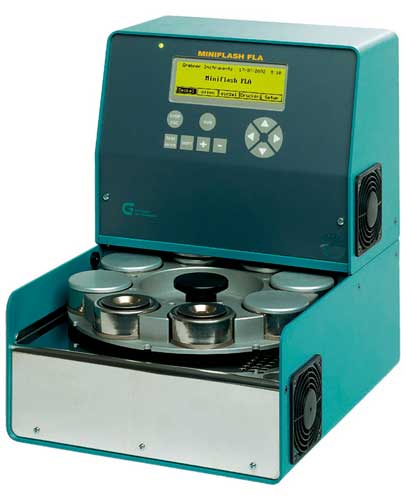 Portable device is designed to test flavors and fragrances. The Miniflash FLA is a portable analyzer that provides easy flashpoint testing of flavors and fragrances. The device has a continuous closed cup design that requires a small volume of sample (1 mL –2 mL). The Miniflash FLA is part of the Grabner Instruments line of flashpoint detectors that measure instantaneous pressure increase inside a closed chamber. Ametek Petrolab Co., petrolab.com, Booth 741
Portable device is designed to test flavors and fragrances. The Miniflash FLA is a portable analyzer that provides easy flashpoint testing of flavors and fragrances. The device has a continuous closed cup design that requires a small volume of sample (1 mL –2 mL). The Miniflash FLA is part of the Grabner Instruments line of flashpoint detectors that measure instantaneous pressure increase inside a closed chamber. Ametek Petrolab Co., petrolab.com, Booth 741
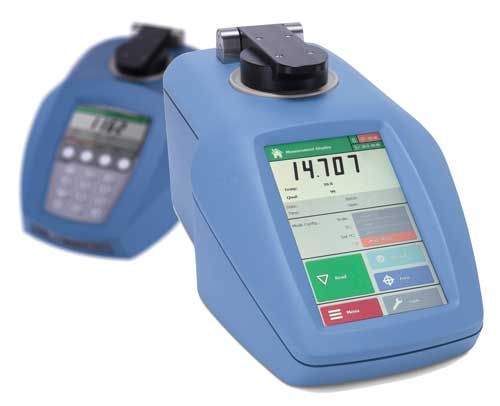 Controlled refractometers deliver thermally stable results. The RFM300+ and RFM300-T series of refractometers are high precision Peltier temperature-controlled benchtop instruments that are capable of measuring non-homogeneous samples, opaque compounds, and emulsions. These devices provide results across a wide refractive index range and guidance through a seven-inch high-definition color touchscreen. The refractometers can also export results as PDF files via USB device. Bellingham + Stanley, a Xylem Brand, bellinghamandstanley.com, Booth 3409
Controlled refractometers deliver thermally stable results. The RFM300+ and RFM300-T series of refractometers are high precision Peltier temperature-controlled benchtop instruments that are capable of measuring non-homogeneous samples, opaque compounds, and emulsions. These devices provide results across a wide refractive index range and guidance through a seven-inch high-definition color touchscreen. The refractometers can also export results as PDF files via USB device. Bellingham + Stanley, a Xylem Brand, bellinghamandstanley.com, Booth 3409
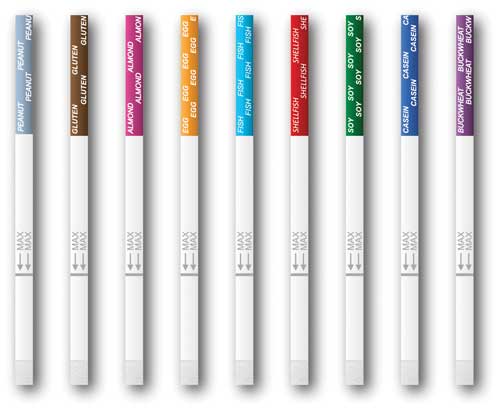 Identify and prevent food allergen contamination in minutes. Agitest rapid test kits detect nine major food allergens (almond, buckwheat, codfish, egg, gluten, milk, peanuts, shellfish, and soy) in raw materials and processed foods. The tests provide results in 15 minutes, which facilitates real-time decisions. The strips come in different colors to differentiate each allergen. Rega Biotechnology Inc., regabio.com, Booth 4319
Identify and prevent food allergen contamination in minutes. Agitest rapid test kits detect nine major food allergens (almond, buckwheat, codfish, egg, gluten, milk, peanuts, shellfish, and soy) in raw materials and processed foods. The tests provide results in 15 minutes, which facilitates real-time decisions. The strips come in different colors to differentiate each allergen. Rega Biotechnology Inc., regabio.com, Booth 4319
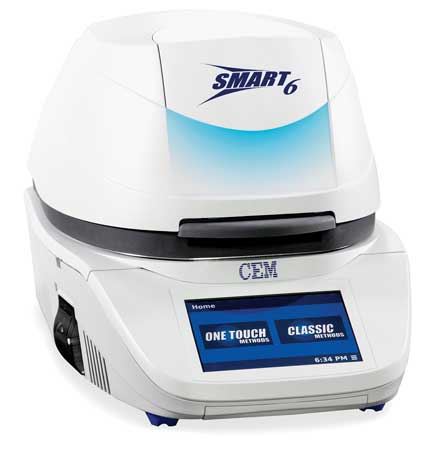 Innovative direct analyzer distinguishes itself from others. The SMART 6 Moisture/Solids Analyzer features iPower technology, which employs a multi-frequency energy source for sample drying. As a result, this instrument accurately measures the moisture, solids, or volatile content of wet and dry samples in a speedy time period. The SMART 6 also features a high resolution touchscreen and facilitates a complete statistical analysis of results. CEM Corp., cem.com, Booth 4415
Innovative direct analyzer distinguishes itself from others. The SMART 6 Moisture/Solids Analyzer features iPower technology, which employs a multi-frequency energy source for sample drying. As a result, this instrument accurately measures the moisture, solids, or volatile content of wet and dry samples in a speedy time period. The SMART 6 also features a high resolution touchscreen and facilitates a complete statistical analysis of results. CEM Corp., cem.com, Booth 4415
Laboratory services and quality assurance are available at a Chicago-based lab. Biogenesis Analytical Laboratory provides food manufacturers and foodservice companies with a wide range of analytical services and educational consulting. The company delivers accurate results for microbiological testing, quality control testing, and environmental analysis as well as training on food safety and quality assurance. Biogenesis Analytical Laboratory, biogenesisanalytical.com, Booth 749
Single use sampling products comply with U.S. and European government specifications. DispoSamplers are single-use sampling products that can be used with liquids, viscous materials, powders, grains, pellets, and so on. Individually wrapped, these sampling products are manufactured, assembled, and packaged in a class 7 clean room and can be sterilized by gamma irradiation if desired. Dynalab Corp., dynalabcorp.com, Booth 3862
Cleaning solution sanitizes hard-to-clean areas without water. DrySan Duo by Ecolab is a two-in-one cleaner and sanitizer for dry processing environments. The cleaner reduces the risk of microbial contamination yet requires no rinsing between cleaning and sanitizing. The company also offers Advantis Soft Metal FC, a specialized self-foaming cleaner for soft metal equipment that provides optimal cleaning at variable temperatures. Ecolab Inc., ecolab.com, Booth 1814
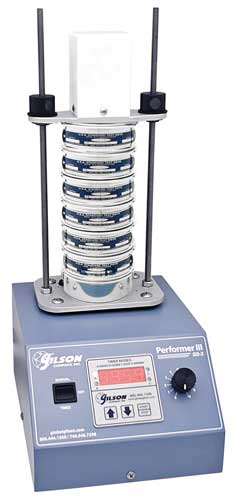 Powerful tool separates samples. The SS-3 Performer III 3in Sieve Shaker is a benchtop unit that efficiently separates small samples of dry granular materials and fine powders. This quiet instrument uses electromagnetic vibratory action to separate sample sizes accurately and features a clamping system that secures sieve stacks quickly and easily. The manufacturer also has a sieve shaker for 8-inch sieves. Gilson Co. Inc., globalgilson.com, Booth 4105
Powerful tool separates samples. The SS-3 Performer III 3in Sieve Shaker is a benchtop unit that efficiently separates small samples of dry granular materials and fine powders. This quiet instrument uses electromagnetic vibratory action to separate sample sizes accurately and features a clamping system that secures sieve stacks quickly and easily. The manufacturer also has a sieve shaker for 8-inch sieves. Gilson Co. Inc., globalgilson.com, Booth 4105
A suite of software products analyzes nutrition and makes labels. The Genesis R&D Food Analysis and Labeling software analyzes the nutritional content of product recipes and generates camera-ready Nutrition Facts panels. The program automatically builds ingredient and allergen statements, features HACCP guidelines, and complies with country-specific government labeling laws. It also generates barcodes for labels. A similar software program now exists for the supplement industry. ESHA Research Inc., esha.com, Booth 1318
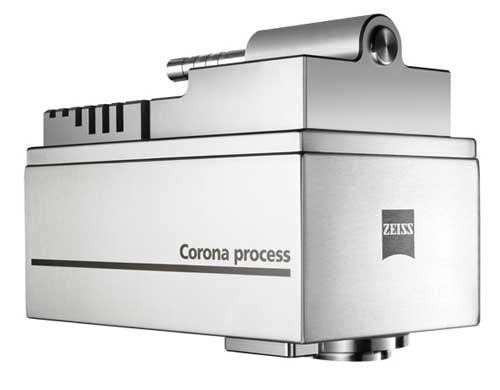 Near-infrared technology precisely measures parameters. The Corona spectrometer system combines a spectrometer with calibration and intuitive software to provide precise measurements. The near-infrared system is based on diode-array technology and determines moisture, fat, and protein content. It is ideal for bakery products, coffee and tea processing, dairy powders, and snack products. ZEISS International provides a range of other spectroscopy instruments. ZEISS International, www.zeiss.com/spectroscopy, Booth 4003
Near-infrared technology precisely measures parameters. The Corona spectrometer system combines a spectrometer with calibration and intuitive software to provide precise measurements. The near-infrared system is based on diode-array technology and determines moisture, fat, and protein content. It is ideal for bakery products, coffee and tea processing, dairy powders, and snack products. ZEISS International provides a range of other spectroscopy instruments. ZEISS International, www.zeiss.com/spectroscopy, Booth 4003
Uniaxial tester for powders offers reliability. The Uniaxial Powder Tester by Freeman Technology is a standalone shear tester that characterizes powders. It utilizes the formation of a consolidated column of powder that is fractured through the application of a vertical stress, which allows users to measure uUYS and flow function. Results are easy to interpret and reliable. Freeman Technology, freemantech.co.uk, Booth 339
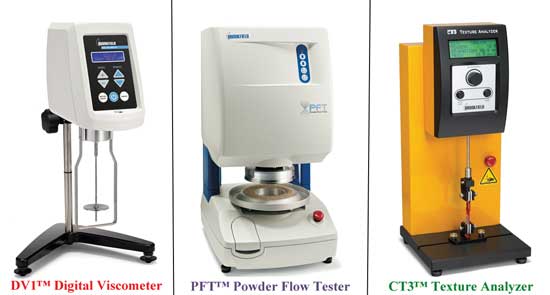 Testing instruments ensure product quality. Brookfield AMETEK Inc. provides instruments that measure viscosity and analyze control, texture, and powder flow. The economical DV1 Viscometer not only measures viscosity but also temperature. The CT3 Texture Analyzer is ideal for testing tension and compression. The PFT Powder Flow Tester analyzes powder flow behavior in industrial processing equipment. These instruments also have touchscreen functionality. Brookfield AMETEK, brookfieldengineering.com, Booth 1712
Testing instruments ensure product quality. Brookfield AMETEK Inc. provides instruments that measure viscosity and analyze control, texture, and powder flow. The economical DV1 Viscometer not only measures viscosity but also temperature. The CT3 Texture Analyzer is ideal for testing tension and compression. The PFT Powder Flow Tester analyzes powder flow behavior in industrial processing equipment. These instruments also have touchscreen functionality. Brookfield AMETEK, brookfieldengineering.com, Booth 1712
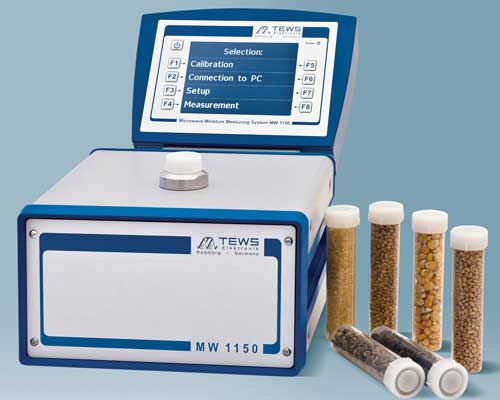 Obtain accurate measurements of moisture content in seconds. TEWS Elektronik produces instruments that accurately determine moisture content and density. The MW 4300 measures moisture content in product samples without sample preparation. Designed for the lab or a process line, the MW 1150 is a compact instrument that provides microwave moisture measurement in less than a second. And the MW 4260 is designed for rapid moisture analysis on a process line. TEWS Elektronik, tews-elektronik.com, Booth 4718
Obtain accurate measurements of moisture content in seconds. TEWS Elektronik produces instruments that accurately determine moisture content and density. The MW 4300 measures moisture content in product samples without sample preparation. Designed for the lab or a process line, the MW 1150 is a compact instrument that provides microwave moisture measurement in less than a second. And the MW 4260 is designed for rapid moisture analysis on a process line. TEWS Elektronik, tews-elektronik.com, Booth 4718
Two new instruments monitor homogenization at a low cost. The LA-350 Laser Diffraction Particle Size Analyzer combines a built-in system for ultrasonic sample dispersion and a powerful pumping system with a wide range of automated software features into a compact size. The LA-960 Laser Particle Size Analyzer provides state-of-the-art measurement of nanoparticles while utilizing advanced software that emphasizes ease of use. Both tools are low-cost solutions to monitor homogenization processes. Horiba Instruments Inc., horiba.com, Booth 1881
Ensure compliance with a central system for lab management. LabVantage 8 simplifies daily laboratory management with a complete browser-based user interface, out-of-the-box functionalities, and system lifecycle management. The system also provides the ability to manage tests across multiple plan items, traceability and easy data retrieval, calendar views, and functions that accelerate new product development. LabVantage Solutions Inc., labvantage.com, Booth 4524
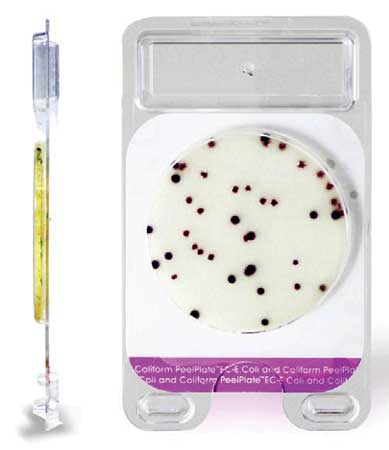 Ready-to-use plates for microbial testing maximize productivity. Peel Plate Microbial Tests provide simplified culture methods for detecting microorganisms. Each test consists of a prepared medium in a shallow dish with an adhesive top and is stackable. These ready-to-use tests are available for aerobic plate count, coliform bacteria, E. coli, yeasts, and molds. Weber Scientific, weberscientific.com, Booth 3848
Ready-to-use plates for microbial testing maximize productivity. Peel Plate Microbial Tests provide simplified culture methods for detecting microorganisms. Each test consists of a prepared medium in a shallow dish with an adhesive top and is stackable. These ready-to-use tests are available for aerobic plate count, coliform bacteria, E. coli, yeasts, and molds. Weber Scientific, weberscientific.com, Booth 3848
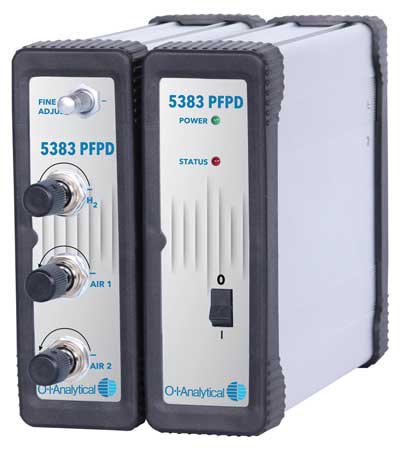 New products determine aromatic compounds and more. Xylem Analytics offers products that ensure safety and quality across the food and beverage cycle. The PFPD GC Detector by OI Analytical determines sulfur and other aromatic compounds in flavor extracts and essential oils and sulfur compounds in beverages and pesticide residues. The company also offers a line of precision thermometers and data loggers by ebro and electrodes and laboratory meters by SI Analytics. Xylem Analytics, xylem.com, Booth 3409
New products determine aromatic compounds and more. Xylem Analytics offers products that ensure safety and quality across the food and beverage cycle. The PFPD GC Detector by OI Analytical determines sulfur and other aromatic compounds in flavor extracts and essential oils and sulfur compounds in beverages and pesticide residues. The company also offers a line of precision thermometers and data loggers by ebro and electrodes and laboratory meters by SI Analytics. Xylem Analytics, xylem.com, Booth 3409
Switch from subjective measurement to objective analysis. The Lovibond EComparator Series ensures an easy transition from visual measurement to accurate electronic measurement for color analysis. These instruments have an intuitive interface, which facilitates quick learning and adaptation with on-screen color and numerical displays. In addition, touchscreen technology makes the instruments easy to program with immediate, accurate results. Paul N. Gardner Co., gardco.com, Booth 4351
Explore testing that ensures food safety and food quality. PerkinElmer is a global leader in improving the health and safety of consumers. The company provides food testing technologies that help ensure the safety and quality of some of the worlds’ most popular consumer products and brands. PerkinElmer, perkinelmer.com, Booth 431
Probiotic product increases food safety and food quality. Pre-Laminate is a custom brand of dry probiotic powders that prevent and eliminate pathogens in food and on food contact surfaces. The powders consist of strains of Lactobacillus and Bifidobacterium that are effective against Salmonella, Listeria, and Clostridium. The powders are customizable to meet client specifications and made with blends of select microorganisms. Log10, log10.com, Booth 4525
The protein sector has been turned on its head. The In Vitro Protein Digestibility Corrected Amino Acid Score is a service from Medallion Labs that safely measures the protein quality of alternative proteins in finished products. The method reduces cost and turnaround times, delivers high accuracy and correlation, and eliminates the need to use animal feeding studies. Medallion Labs also provides chemical analysis, dietary fiber testing, microbiological analysis, and shelf life studies. Medallion Labs, medlabs.com, Booth 1636
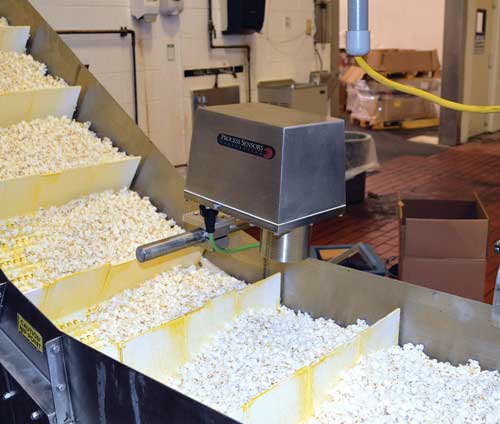 Measure moisture and oil content of snacks. The MCT466-SF is a robust, reliable near infrared gauge that determines moisture content of products on conveyor lines. It is made of 316 stainless steel and is designed to measure moisture and oil in demanding hot food-processing environments. In addition, the MCT466-SF meets the hygiene and safety requirements of food manufacturing plants. Process Sensors Corp., processsensors.com, Booth 4453
Measure moisture and oil content of snacks. The MCT466-SF is a robust, reliable near infrared gauge that determines moisture content of products on conveyor lines. It is made of 316 stainless steel and is designed to measure moisture and oil in demanding hot food-processing environments. In addition, the MCT466-SF meets the hygiene and safety requirements of food manufacturing plants. Process Sensors Corp., processsensors.com, Booth 4453
A comprehensive laboratory offers food testing. rTech Laboratories, a business unit of Land O’Lakes Inc., provides a complete array of analytical chemistry and microbiology testing, sensory and consumer research, nutrition labeling services, and information research services. rTech Laboratories, rtechlabs.com, Booth 2606
A leading provider of food safety and quality services now has two operations in Florida. Mérieux NutriSciences has acquired ABC Research Holding Co. LLC in Gainesville, Fla., making it Mérieux NutriSciences’ second full-service laboratory operation in the region. Mérieux NutriSciences provides food-testing and consulting services, including microbiological analysis, nutrient analysis, sensory evaluation, training, and consulting services for regulatory issues. Mérieux NutriSciences, merieuxnutrisciences.com, Booth 2336
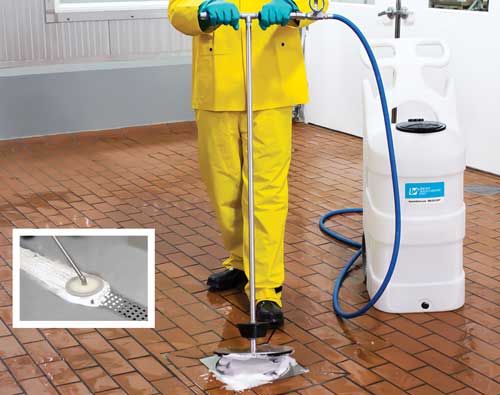 Sanitzers reduce risk of cross-contamination in processing facilities. The Alpet No-Rinse Quat Sanitizer can be used on all surfaces, including those that come in contact with food. The product sanitizes surfaces in 60 seconds, disinfects them in 10 minutes, and can be diluted. The sanitizer is ideal for Best Sanitizer Inc.’s drain cleaning foaming accessories. Best Sanitizers Inc., bestsanitizers.com, Booth 4417
Sanitzers reduce risk of cross-contamination in processing facilities. The Alpet No-Rinse Quat Sanitizer can be used on all surfaces, including those that come in contact with food. The product sanitizes surfaces in 60 seconds, disinfects them in 10 minutes, and can be diluted. The sanitizer is ideal for Best Sanitizer Inc.’s drain cleaning foaming accessories. Best Sanitizers Inc., bestsanitizers.com, Booth 4417
Streamline access to training and other academic resources. Soft & Hybrid Nanotechnology Experimental (SHyNE) Resource can support food and beverage research and development needs by providing access to instrumentation, training, and technical expertise from two prestigious universities: Northwestern University and University of Chicago. Resources are available for sample preparation, microscopy, and chemical and molecular analysis. SHyNE Resource, shyne.northwestern.edu, Booth 849
Analyze aroma compounds in seconds. Syft Technologies provides mass spectrometry instruments that analyze trace levels of aroma compounds in seconds. The process does not require sample preparation or modification, and the analysis is free of chromatography. Syft’s mass spectrometry instruments detect defective products sooner and provide objective real-time aroma analysis. Syft Technologies, syft.com, Booth 3477
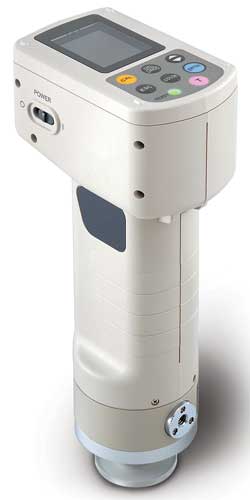 Determine coloring issues with handheld devices. The BC-10 Baking Contrast Meter is a handheld portable colorimeter that evaluates the color of baked, fried, smoked, and processed foods. The device allows users to efficiently meet quality standards for colors by measuring color and hue characteristics. The CR-400 Chroma Meter is another handheld device capable of evaluating the color of objects with smoother surfaces or minimal color variation. Konica Minolta Sensing Americas Inc., sensing.konicaminolta.us, Booth 2956
Determine coloring issues with handheld devices. The BC-10 Baking Contrast Meter is a handheld portable colorimeter that evaluates the color of baked, fried, smoked, and processed foods. The device allows users to efficiently meet quality standards for colors by measuring color and hue characteristics. The CR-400 Chroma Meter is another handheld device capable of evaluating the color of objects with smoother surfaces or minimal color variation. Konica Minolta Sensing Americas Inc., sensing.konicaminolta.us, Booth 2956
 Neil H. Mermelstein, IFT Fellow,
Neil H. Mermelstein, IFT Fellow,
Editor Emeritus of Food Technology
[email protected]


